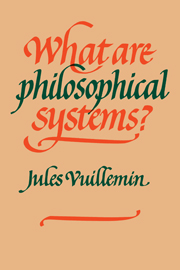3 - AXIOMATICS, ONTOLOGIES, PHILOSOPHIES
Published online by Cambridge University Press: 04 August 2010
Summary
There are civilizations without philosophy, and there are civilizations where philosophy never could, and those where it never can, disentangle itself from a certain bondage to custom, law and social utility. Free philosophy, therefore, as opposed to Church- or state-organized ideology, must have arisen from a revolution in the use of the signs by means of which, for every civilization, language represents the sensible world. What was and still is the force which protects the old order of signs? What is the weak point in the net of the elementary sentences? Where can we expect innovations to subdue this conservative force? The first part of this chapter seeks to answer these questions by analysing the nature of myth: the development of free philosophy will appear as correlated with the development of the axiomatic method. The two go paired together like the Dioscuri. The second part of the chapter will examine the manner in which philosophy and axiomatics give signs a new interpretation.
FROM MYTH TO PHILOSOPHY; THE ROLE OF THE AXIOMATIC METHOD
According to Helmholtz's principle, the signals which constitute perceptual organization are spontaneously interpreted as objective things. An analogous principle is valid for language and the sensible world. The elementary sentences certainly admit of local distinctions between appearance and reality. But appearances are spread out as so many puddles which never conjoin into one and the same river.
- Type
- Chapter
- Information
- What Are Philosophical Systems? , pp. 96 - 114Publisher: Cambridge University PressPrint publication year: 1986



